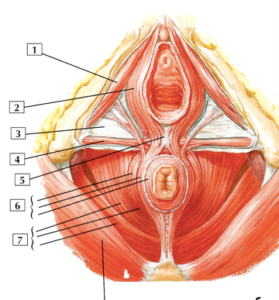Feel your anatomy
To understand where your pelvic floor muscles are located, sit and place your hands under your sit bones, then feel for your tailbone at the base of your spine and then the pubic bone at the front of your body. In between all of these bony landmarks lie your pelvic floor muscles. This group of muscles is quite often forgotten in anatomy texts even thou it controls some of the most basic and essential body functions. These muscles are used to empty or hold the content of the bladder and rectum as well as for sexual and reproduction purposes. They are responsible for quite a complex task, with the help of ligaments and fascia, they have to hold the organs up but let fluids and matter down.
Pelvic floor and breath
This group of muscles is also being used when we breath. In order to create space for the new air to enter our lungs, the diaphragm (main breathing muscle) and the pelvic floor are going down together when we inhale and up when we exhale. This action acts like a pump to let the air in and then push it out. If the pelvic floor is held tight when we breath in, we restrict the amount of air entering the body. To feel this connection between the pelvic floor and diaphragm, try to tighten your pelvic floor muscles (as if you wanted to stop yourself from going to the toilet) and take a deep breath. Now release your pelvic floor, bring your attention to these muscles again and take another breath. Notice the difference? Do you feel that you can breathe deeper?
Postural imbalances and pelvic floor
The pelvic floor muscles are also closely linked to the postural muscles (muscles holding us upright). Poor posture can result in pelvic floor dysfunction and vice versa. You might notice that it is easier to hold on a pee if you are standing upright or seating in a chair rather than if you are slouching on the couch or seated cross-legged. In Ortho-Bionomy as well as in Osteopathy we follow a simple principle called ‘structure governs function’. In other words, the bones (structure) needs to be aligned in order for the muscles and organs to function efficiently. If the pelvis is misaligned due to poor posture, the muscles of pelvic floor will not be able to perform as well.
Core stability and pelvic floor
To protect the pelvic floor from unnecessary pressure, it needs to be supported when practicing any type of activity requiring the abdominal muscles (such as pushing, lifting and core exercises). Imagine what is happening to the content of the belly while doing sit-ups without any pelvic floor support. When the abdominal muscles contract to lift the torso up towards your knees, the space between the ribs and hips becomes smaller and the organs have nowhere to go but to be pushed down on the pelvic floor or up on the diaphragm. Overtime this can decrease the efficacy of the pelvic floor.
To learn how to support your pelvic floor, look up: hypopressive core exercise or join me in my next pelvic floor workshop. In this workshop you will learn to feel the connection between your pelvic floor, diaphragm and your posture. You will also discover an easy way to find your perfect alignment and how to practice any type of core activity safely.

Female pelvic floor: 1- Ischiocavernosus muscle 2-Bulbospongiosus muscle 3-Perineal membrane 4-Superficial transverse perineal muscle 5-Perineal body 6-Parts of external anal sphincter muscle 7-Levator ani muscle
Image by HANSEN John T, Netter’s Anatomy flash card 5-4, 4th edition, Elsevier Health Science, 2014
Reference: DE GASQUET, Bernadette. Périnée arrêtons le massacre!. Paris: Hachette Livre, Marabout, 2011
